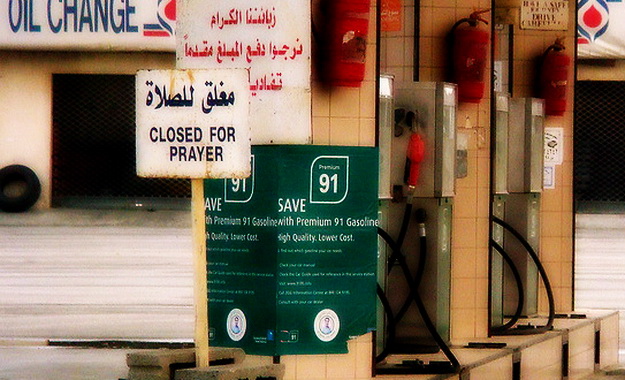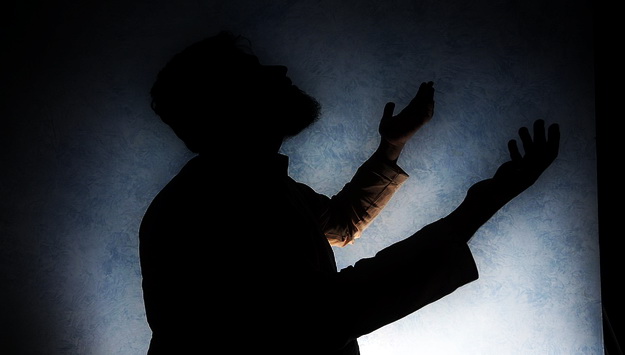Praise be to Allaah.
Allaah says in the Quran:
“Verily, the prayer is enjoined on the believers at fixed hours.” [Surah an-Nisa’, 4:103]
Allaah has enjoined upon His slaves five prayers throughout the day and night at specific times decreed by the wisdom of Allaah so that the slave may be in contact with his Lord in these prayers throughout all of these times. They are for the heart like water for a tree, given to it time after time, not all in one go and then it stops.
Part of the wisdom behind doing the prayers at these times is so that people will not get bored or find it too difficult, which would happen if they all had to be done at once. Blessed be Allaah, the Wisest of judges.
(From the Introduction to Risaalat Ahkaam Mawaaqeet al-Salaah (Essay on the Rulings on the Times of the Prayers) by Shaykh Muhammad ibn ‘Uthaymeen, may Allaah have mercy on him).
Abdullah bin Mas’ood (radhiAllahu anhu) narrated:
I asked the Prophet (Sallallahu alayhi wassallam), “Which deed is the dearest to Allaah?” He replied, “To offer the prayers at their stated fixed times.” I asked, “What is next (in goodness)?” He replied, “To be good and dutiful to your parents.” I asked again, “What is next (in goodness)?” He replied, “To partcipate in Jihaad (religious fighting) in Allaah’s cause.” Abdullah added, “These were told by Allah’s Messenger (Sallallahu alayhi wassallam) and if I had asked more, he (Sallallahu alayhi wassallam) would have told me more.” [Bukhari, Times of As-Salat, Chapter: Superiority of performing Salah at the fixed times, Hadith: 527]
Muhammad bin Amr said:
When Hajjaj came to Al-Madinah, we asked Jabir bin Abdullah (radhiAllahu anhu) about the timing of prayers as observed by the Prophet (Sallallahu alayhi wassallam) and he said:
“The Prophet (Sallallahu alayhi wassallam) used to perform Zuhr prayer at midday and the ‘Asr at a time when the sun was still bright, the Maghrib after sunset (at its stated time) and ‘Isha’ at a variable time. Whenever he (Sallallahu alayhi wassallam) saw the people assembled (for ‘Isha’ prayer) he (Sallallahu alayhi wassallam) would perform Salah earlier and if the people delayed, he (Sallallahu alayhi wassallam) would delay the Salah. And they or the Prophet (Sallallahu alayhi wassallam) used to perform the Fajr prayer when it was still dark (at its earliest time).” [Bukhari, Times of As-Salat, Chapter: The times of the Maghrib prayer, Hadith: 560]
The times of the prayers were mentioned by the Prophet (Sallallahu alayhi wassallam) in the hadeeth:
“The time for Zuhr is from when the sun has passed its zenith and a man’s shadow is equal in length to his height, until the time for ‘Asr comes. The time for ‘Asr lasts until the sun turns yellow. The time for Maghrib lasts until the twilight has faded. The time for ‘Isha’ lasts until midnight. The time for Subh (Fajr) prayer lasts from the beginning of the pre-dawn so long as the sun has not yet started to rise. When the sun starts to rise then stop praying, for it rises between the two horns of the Shaytaan.” [Narrated by Muslim, 612].
This hadeeth explains the timings of the five daily prayers. As for defining them by the clock, that varies from one city or country to another. We will define each in more detail as follows:
1 – The time of Zuhr
The Prophet (Sallallahu alayhi wassallam) said:
“The time for Zuhr is from when the sun has passed its zenith and a man’s shadow is equal in length to his height, until the time for ‘Asr comes.” So the Prophet (Sallallahu alayhi wassallam) defined the start and the end of the time for Zuhr:
The start of the time for Zuhr is when the sun has passed its zenith i.e., has passed the highest part of the sky and started to descend towards the west.
Practical way of knowing when the zenith has been passed (and the time for Zuhr has begun):
Put a stick or pole in an open place. When the sun rises in the east, the shadow of this stick will fall towards the west. The higher the sun rises, the shorter the shadow will become. So long as it keeps growing shorter, the sun has not yet reached its zenith. The shadow will keep on growing shorter until it reaches a certain point, then it will start to increase, falling towards the east. When it increases by even a small amount, then the sun has passed its zenith. At that point the time for Zuhr has begun.
Knowing the time of the zenith by the clock: divide the time between sunrise and sunset in half, and that is the time of the zenith. If we assume that the sun rises at 6 a.m. and sets at 6 p.m., then the zenith is at 12 noon. If it rises at 7 a.m. and sets at 7 p.m., then the zenith is at 1 p.m., and so on.
See al-Sharh al-Mumti’, 2/96
The end of the time for Zuhr is when the shadow of everything is equal in length to the object itself, plus the length of the shadow of the object at the time of the zenith.
Practical way of knowing when the time for Zuhr has ended:
Go back to the stick or pole which we described above. Let us assume that its length is one meter. We will notice that before the sun reached its zenith, the shadow decreased gradually until it reached a certain point (make a mark at this point), then it started to increase, at which point the time for Zuhr began. The shadow will continue to increase, falling towards the east until the length of the shadow is equal to the length of the object itself, i.e., it will be one meter long, starting from the point marked at the zenith). As for the shadow before the mark, that is not counted, and it is called fay’ al-zawaal (the shadow of the zenith). At this point the time for Zuhr ends and the time for ‘Asr begins straight away.
2 – The time of ‘Asr
The Prophet (Sallallahu alayhi wassallam) said:
“The time for ‘Asr lasts until the sun turns yellow.”
We know that the time for ‘Asr begins when the time for Zuhr ends, i.e., when the length of an object’s shadow becomes equal to the length of the object itself. There are two times for the end of ‘Asr.
(1) The preferred time: this lasts from the beginning of the time for ‘Asr until the sun begins to turn yellow, because the Prophet (Sallallahu alayhi wassallam) said: “The time for ‘Asr lasts until the sun turns yellow.” Defining this time by the clock varies according to the season.
(2) The time of necessity: This lasts from the time the sun turns yellow until sunset, because the Prophet (Sallallahu alayhi wassallam) said:
“Whoever catches up with one rak’ah of ‘Asr before the sun sets has caught up with ‘Asr.” [Narrated by al-Bukhaari, 579; Muslim, 608]
Question: what is meant by the time of necessity?
Necessity here refers to when a person is distracted from praying ‘Asr by some essential and unavoidable work, such as dressing wounds, and he is able to pray before the sun turns yellow but it is difficult, then he prays just before sunset. In this case he has prayed on time and has not sinned, because this is the time of necessity. If a person is forced to delay the prayer, there is no sin so long as he prays before the sun sets.
3 – The time of Maghrib
The Prophet (Sallallahu alayhi wassallam) said: “The time for Maghrib lasts until the twilight has faded.”
i.e., the time for Maghrib starts immediately after the time for ‘Asr ends, which is when the sun sets, until the twilight or red afterglow has faded. When the red afterglow has disappeared from the sky, the time for Maghrib ends and the time for ‘Isha’ begins. Defining this time by the clock varies according to the season. When you see that the red afterglow has disappeared from the horizon, this is a sign that the time for Maghrib has ended.
4 – The time of ‘Isha
The Prophet (Sallallahu alayhi wassallam) said: “The time for ‘Isha’ lasts until midnight.”
So the time for ‘Isha’ begins immediately after the time for Maghrib ends (i.e., when the red afterglow disappears from the sky) until midnight.
Question: how do we calculate when midnight is?
Answer: if you want to calculate when midnight is, then calculate the time between sunset and sunrise then divide it in half; that halfway point is the end of the time for praying ‘Isha’ (and that is midnight).
So if the sun sets at 5 p.m., and Fajr begins at 5 a.m., then midnight is 11 p.m. If the sun sets at 5 p.m. and Fajr begins at 6 p.m., then midnight is 11.30 p.m., and so on.
5 – The time of Fajr
The Prophet (Sallallahu alayhi wassallam) said: “The time for Subh (Fajr) prayer lasts from the beginning of the pre-dawn so long as the sun has not yet started to rise. When the sun starts to rise then stop praying, for it rises between the two horns of the Shaytaan.”
The time for Fajr begins with the onset of the “second dawn” (al-fajr al-thaani) and ends when the sun starts to rise. The “second dawn” is the brightness that appears along the horizon in the east and extends north to south. The “first dawn” (al-fajr al-awwal) occurs approximately one hour before this, and there are differences between the two:
(1) In the “first dawn” the brightness extends from east to west, and in the “second dawn” it extends from north to south.
(2) The “first dawn” is followed by darkness, i.e., the brightness lasts for a short period then it becomes dark. The “second dawn” is not followed by darkness, rather the light increases.
(3) The “second dawn” is connected to the horizon, with no darkness between it and the horizon, whereas the “first dawn” is separated from the horizon with darkness between it and the horizon.
See al-Sharh al-Mumti’, 2/107.
The time of Fajr and mistakes in some timetables
Allaah has made it easy for the Muslims by causing timetables to be available which show the times of the prayer in detail, day by day, summer and winter, for different cities in one country. And there are mosques everywhere that give the call to prayer, which is an announcement of the time. To Allaah be praise. If each person had to look each day to the horizon in order to work out the time for Fajr, and think about the shadows and how long or short they were, to work out the time for Zuhr and ‘Asr, that would involve a great deal of hardship, which is not a part of this great religion.
Although timetables are important and useful, they are a human effort which is subject to the same mistakes and errors as any other human effort. But usually they are correct in stating the times, except for the mistake in the time for Fajr which occurs in some of them, as is explained below.
Note that the time for Fajr prayer begins when the second dawn starts, which is the white line that spreads horizontally along the horizon right and left. The time lasts until the sun rises.
The first dawn is the false dawn, which is whiteness that appears vertically in the sky like pillars. This happens approximately twenty minutes before the true dawn, and it increases and decreases according to the season.
It is known that the rulings apply to the true dawn, not the false dawn.
There are many ahaadeeth which speak about the two dawns, such as the following:
The Prophet (Sallallahu alayhi wassallam) said: “There are two dawns, the dawn when food becomes haraam and prayer becomes permissible, and the dawn when prayer (i.e., Fajr prayer) is haraam and food is permitted.” [Narrated by al-Haakim and al-Bayhaqi from the hadeeth of Ibn ‘Abbaas; classed as saheeh by al-Albaani in Saheeh al-Jaami’, 4279]
And the Prophet (Sallallahu alayhi wassallam) said: “There are two dawns. With regard to the dawn which is like the tail of a wolf, this does not make it permissible to pray and haraam to eat. With regard to the dawn which appears horizontally in the sky, this makes it permissible to pray and forbidden to eat.” [Narrated by al-Haakim and al-Bayhaqi from the hadeeth of Jaabir; classed as saheeh by al-Albaani in Saheeh al-Jaami’, 4278]
According to another report, “There are two dawns. One is called the tail of the wolf, which is the false dawn that appears vertically, not horizontally. The other appears horizontally and not vertically.” [Classed as saheeh by al-Albaani in al-Silsilah al-Saheehah, no. 2202]
And the Prophet (Sallallahu alayhi wassallam) said, “Do not let the adhaan of Bilaal stop you from eating suhoor, or the vertical dawn, but the dawn which appears along the horizon.” [Narrated by Abu Dawood and al-Tirmidhi, who classed it as hasan. Classed as saheeh by al-Albaani inSaheeh al-Tirmidhi, no. 568]
From this explanation given by the Prophet (Sallallahu alayhi wassallam), we know that the definition of the time of Fajr is based on observation, not on astronomical calculations or on timetables whose authors are unknown as far as their trustworthiness and knowledge are concerned, especially if it is proven that they do not give the correct times.
It seems that most of the timetables do not give the correct time for Fajr and are based on the false dawn. This means that there is the risk that the Muslims’ prayers are invalid, especially in the case of those who pray in their houses immediately after hearing the adhaan.
A group of scholars and researchers in the Kingdom of Saudi Arabia, Syria, Egypt and Sudan have attempted to find out the time of the true dawn, and it is clear to them that the timetables in use at present are incorrect.
Shaykh al-Albaani (may Allaah have mercy on him) said:
“I have seen that myself many times in my house, in the Hamlaan mountains to the south-east of Amman, and that enables me to confirm what some of those who are keen that the Muslims’ worship should be correct have said, that the adhaan of Fajr in some Arab countries is given 20-30 minutes before the time of the true dawn, i.e., it is also before the time of the false dawn. I have often heard the iqaamah for Fajr being given in some mosques at the time when the true dawn begins, and they give the adhaan before it is time. And they may hasten to do the fard prayer before it is time during the month of Ramadaan.” [from al-Silsilah al-Saheehah, 5/25]
Once this is understood, the people from each town or city should appoint a group of trustworthy scholars to find out the time of Fajr and to announce that to the people, and warn them against following timetables if it is proven that they are incorrect.
The brother who asked this question, and all Muslims, should not pray Fajr until they are certain or think it most likely that dawn has broken; if they can delay the adhaan until this time, they should do that. They should also explain this ruling to their wives and daughters, lest they end up doing the prayer at the wrong time.
And Allaah knows best.
Source: islamqa.info/en (fatawa numbers: 9940, 26763, 71367)
 navedz.com a muslim's Quest for the truth
navedz.com a muslim's Quest for the truth







